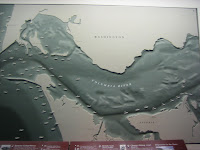
The Columbia River Maritime Museum included a large exhibit as a tribute to the US Coast Guard. This is the "44300" a cutter (I think) that served in hundreds of rescues through its many years of service in the USCG. Retired in 1998, she now serves as a monument to the Coast Guard and is immortalized in the midst of a rescue, tossing a buoy out to a stranded swimmer. Click on the picture for more detail.

The 44300's bow. You can't tell in this picture, but the boat is actually mounted on a tilted platform at a 45 degree angle and this end is around 15 feet from the floor of the room. The 44300 later served as a prototype for future rescue vessels in both the USCG and the British Navy after many years of sucessful service.

While touring the museum, Neal got really, really hungry. We left the museum and drove a few minutes down the street to downtown Astoria where we discovered the weekly farmer's market, held every Sunday for six months of the year. We followed our noses to an open barbeque in a parking lot and then discovered that there was more than just barbeque: there were several stalls selling fresh lemonade, ice cream, sausages, hot dogs and other typical festival-type fare. But we also discovered a stall serving fresh enchiladas and tamales where the tortillas were made as we watched. Yum!

The Astoria farmer's market is a combination farmer's market where one can buy fresh organic local produce, arts and crafts market (you can buy art, clothing, jewelry and even cat toys made with organic catnip!) and food festival (fresh baked goods, Mexican food, etc.). The atmosphere was very festive, crowded with runners from the HTC relay and it all happened on an unusually sunny day in Astoria.

After wandering the market and picking up some goodies for our friends back home, we returned to the museum to tour the now retired Lightship Columbia, a boat that served in the place of a lighthouse on the Columbia River. At the bow is a mushroom anchor, whose shape is designed so that it does not fill with silt. The lightship was used to help guide boats into the Columbia River, as it was very difficult to build a lighthouse on the point.
 We took a drive out to the coast from Portland on an extremely sunny day in Oregon and arrived in the town of Cannon Beach, home of the very recognizable Haystack Rock. If the name doesn't ring a bell for you, Haystack Rock is one of the largest monoliths in the world and it is often featured in movies and television commercials. It also figured prominently into the sailing scenes in the movie "Goonies." Remember that movie?
We took a drive out to the coast from Portland on an extremely sunny day in Oregon and arrived in the town of Cannon Beach, home of the very recognizable Haystack Rock. If the name doesn't ring a bell for you, Haystack Rock is one of the largest monoliths in the world and it is often featured in movies and television commercials. It also figured prominently into the sailing scenes in the movie "Goonies." Remember that movie? 
















